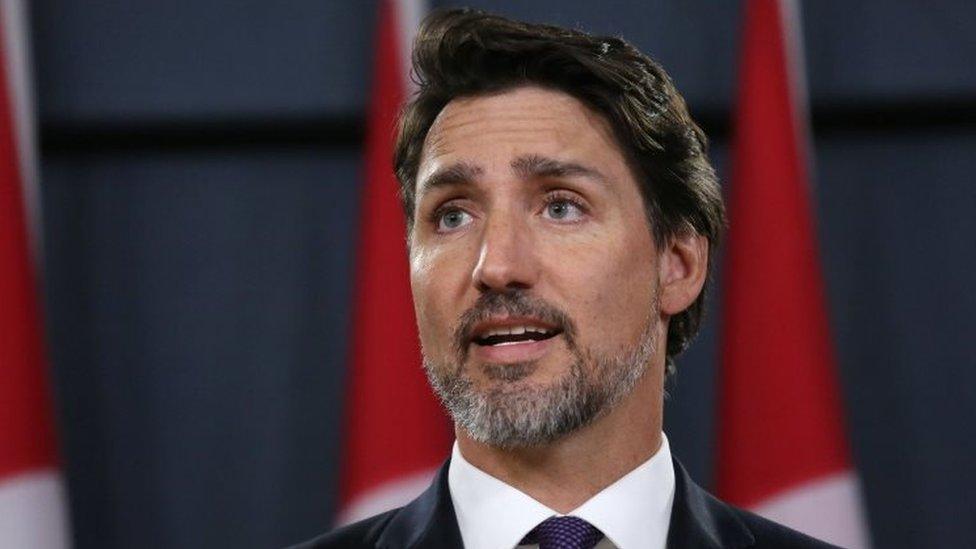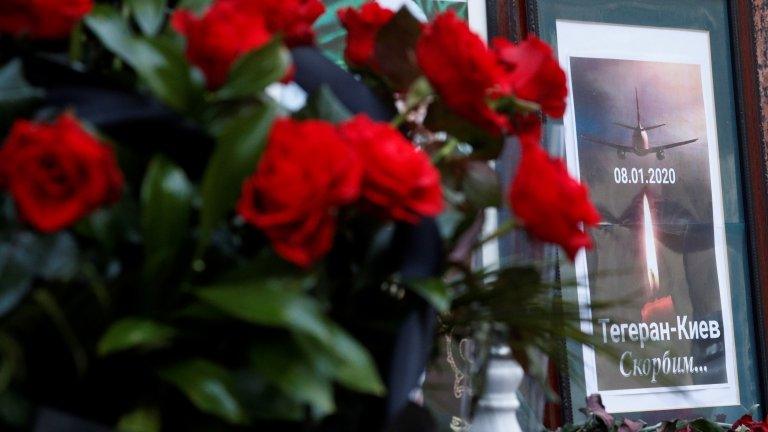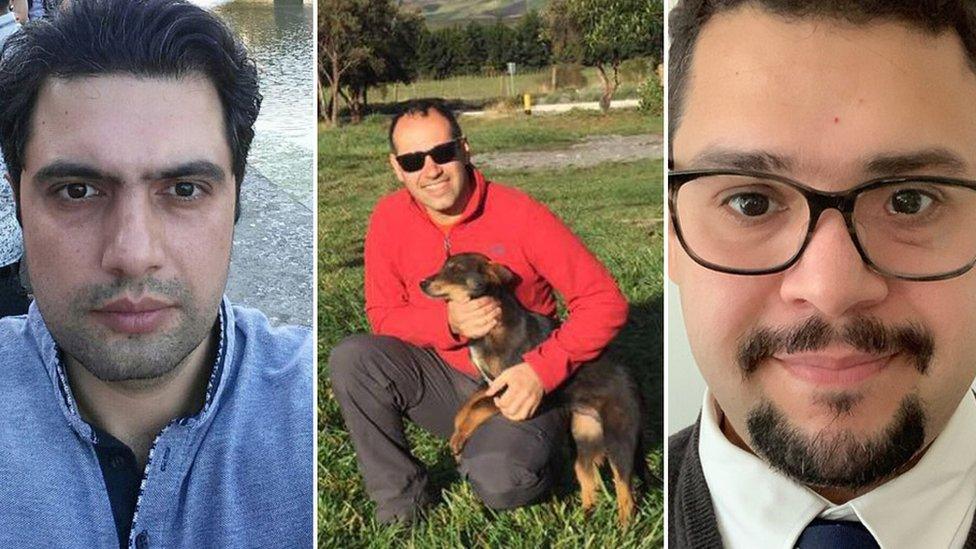Iran plane crash: What we know about flight PS752
- Published
Footage appears to show missile strike on Ukrainian plane in Iran
A Ukraine International Airlines (UIA) flight crashed shortly after taking off from the Iranian capital Tehran on 8 January, killing all 176 passengers and crew members on board.
It came in the midst of escalating tensions between the US and Iran.
After days of denial - and mounting evidence - on Saturday Iran admitted it had shot the Boeing plane down "unintentionally".
Here is what we know.
What happened?
On 8 January, at 06:12 local time (02:42 GMT), UIA flight PS752 took off from Imam Khomeini International Airport.
The plane was a Boeing 737-800 - one of the international airline industry's most widely used aircraft models.
Before it had left the airport's air space, the plane appeared to turn around to return to the runway. Shortly afterwards, it crashed.
Allow X content?
This article contains content provided by X. We ask for your permission before anything is loaded, as they may be using cookies and other technologies. You may want to read X’s cookie policy, external and privacy policy, external before accepting. To view this content choose ‘accept and continue’.

The aircraft's "black boxes", which record flight data and sound within the cockpit, were recovered from the wreckage.
But there have also been reports that mechanical diggers were sent to the crash site before international investigators had arrived, prompting speculation that evidence was being destroyed.
What caused the crash?
The government in Tehran initially said the UIA plane suffered a technical problem shortly after take-off. It cited witnesses including the crew of another passenger plane who said it was on fire prior to impact.
Authorities said they lost radar contact when the plane was at an altitude of about 8,000ft (2,400m), minutes after taking off.


No radio distress call was made by the pilot, the report said.
However, the timing of the accident - just hours after Iran had launched missiles at US targets in Iraq - provoked speculation about other possible causes.
Aviation experts were quick to cast doubt on claims in Iranian state media that the crash was likely to have been caused by an engine fire.
Commercial aircraft are designed to be able to withstand - in general - a failed engine and to land safely.

Justin Trudeau said Canada would not rest until it obtained closure, transparency and justice
On Thursday, Canadian Prime Minister Justin Trudeau said evidence suggested an Iranian missile brought down the aircraft by accident.
"We have intelligence from multiple sources, including our allies and our own intelligence," Mr Trudeau told a news conference in Ottawa. "The evidence indicates that the plane was shot down by an Iranian surface-to-air missile. This may well have been unintentional."
He was echoing earlier reports in US media which said Pentagon officials were confident that the aircraft was shot down.
And evidence was beginning to back up the missile-shooting theory.
Video on social media showed a missile streaking across the night sky and exploding near the plane. (The New York Times later published a video that appeared to show two missiles, external targeting the airliner. It's thought the initial strike disabled the plane's transponder before the second strike around 23 seconds later. )
Three days after the accident, a statement by Iran's military was read on state TV and said the plane was brought down "unintentionally".
Have the Iranians explained everything?
There is general Iranian admission of guilt, but conflicting explanations about the exact sequence of events.
President Hassan Rouhani described the crash as an "unforgivable mistake".

Supreme Leader Ali Khamenei ordered the military to investigate "the possible shortcomings or mistakes" that led to the crash.
The initial Iranian military statement said the plane's downing was due to "human error" after the aircraft had flown close to a "sensitive site" belonging to Iran's Revolutionary Guards Corps .
The commercial airliner was mistaken for a "hostile plane", the statement said.
Hours later, the man responsible for the unit that fired the missile, Revolutionary Guards aerospace commander Brig-Gen Amir Ali Hajizadeh told journalists the aircraft had been shot down by a short-range missile that exploded next to it.
The Iranian operator had mistaken the Boeing for a "cruise missile". They tried to communicate with it and waited for 10 seconds for a reply before deciding to open fire, the general said.
He added that a request had been made for a no-fly zone in the area before the incident but this was rejected. The reasons for this remain unclear.
In fact, it appears the Iranian strikes on US bases did not affect operations at Imam Khomenei International Airport on Wednesday morning. Flight PS752 was the ninth to take off after the strikes, according to Flightradar24.
Is this likely to end the controversy?
Iran's admission of responsibility is an effort at de-escalation, says the BBC's chief international correspondent Lyse Doucet
But an important question remains.
Gen Hajizadeh told the media that he had informed the authorities about what had happened on Wednesday - the day of the accident.
So why did it take three days for Iran to admit it?
The president of Ukraine International Airlines said: "We didn't doubt for a second that our crew and our plane couldn't be the cause for this horrible crash".
But the company has denied that the plane veered from its expected course before the crash. It says officials should have closed the airport.
Ukrainian President Volodymyr Zelensky called on Iran to punish those responsible. "We expect Iran... to bring the guilty to the courts," he said.
And Canadian Prime Minister Justin Trudeau said: "We will continue working with our partners around the world to ensure a complete and thorough investigation."

What will the investigation look like?
Under international protocol, the country where the plane crashes usually leads the investigation.
As the aircraft was made in the US, US officials, including from its National Transportation Safety Board (NTSB), would typically participate in any inquiry.
Iran had initially ruled out handing over any information to the US authorities - after all, in addition to the current tensions, the two countries have no diplomatic relations.
However, Iran's representative at the UN's International Civil Aviation Organization told Reuters on Thursday that Iran had formally invited the NTSB to take part in the investigation, and it has agreed to assign an investigator.
Boeing, the plane's manufacturer, has said it is ready to assist in the investigation and will support the NTSB.
But it is unclear what kind of investigation can be carried out now that it is known the plane did not crash, but was brought down.
Who was on board?
The passenger manifest lists 176 people - 15 of them children - giving their names and dates of birth, but not their nationalities.
Ukrainian Foreign Minister Vadym Prystaiko initially released details that said there were 82 Iranians, 63 Canadians, 11 Ukrainians including all nine crew, 10 Swedes, four Afghans, three Britons and three Germans on board.
However, on 10 January, Canada's Foreign Minister Francois-Philippe Champagne said the number of Canadians on the plane was now believed to be 57.
The German government also contradicted the Ukrainian figures. It said it was not aware that any of its citizens had been on board the flight.
It later emerged that three Afghans - a mother and her two children - who had been granted asylum in the country were passengers on the downed flight.
UK Prime Minister Boris Johnson said on Thursday that four British nationals were on board.
Some of the differences the figures may well be due to dual nationalities.
Iran's head of emergency operations said 147 of the victims were Iranian. That would suggest that 65 of the foreign nationals had dual nationalities, which Iran does not recognise.
- Published9 January 2020

- Published9 January 2020

- Published16 January 2020

- Published8 January 2020
